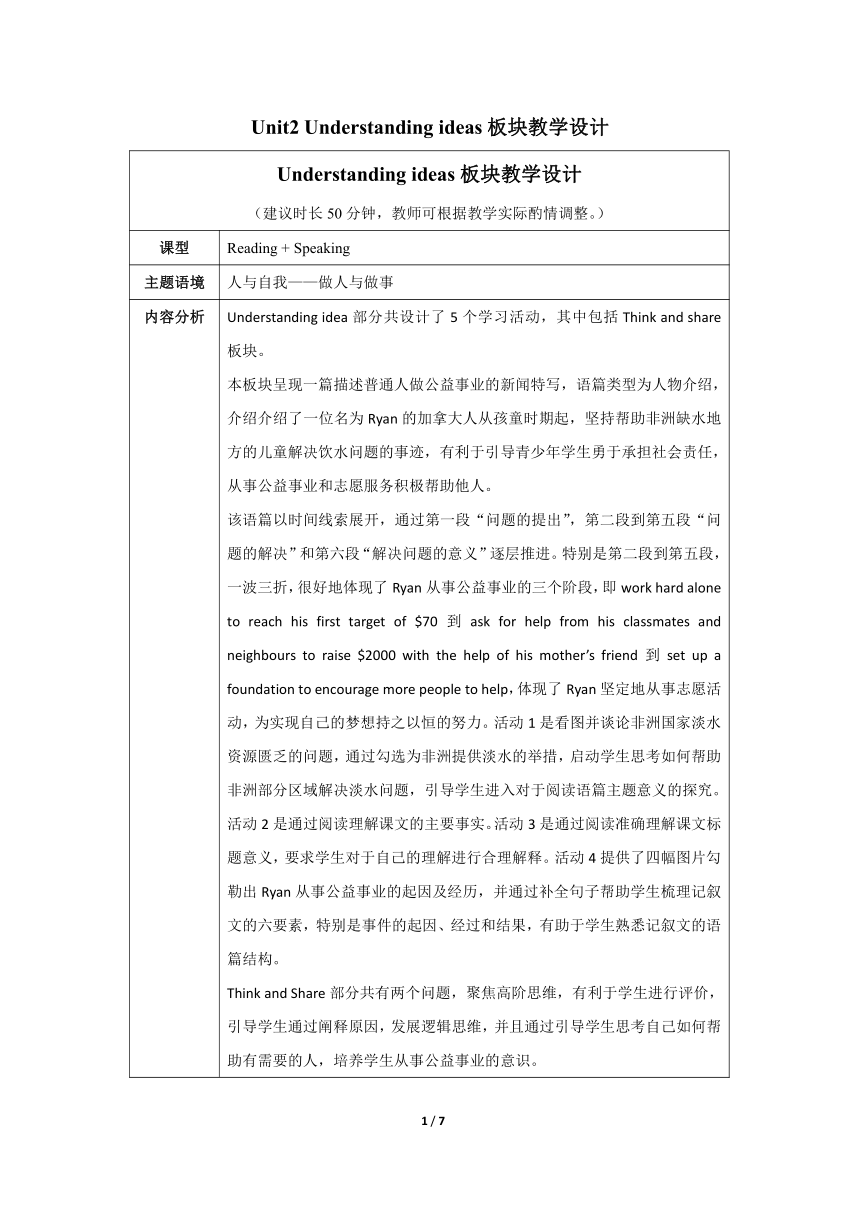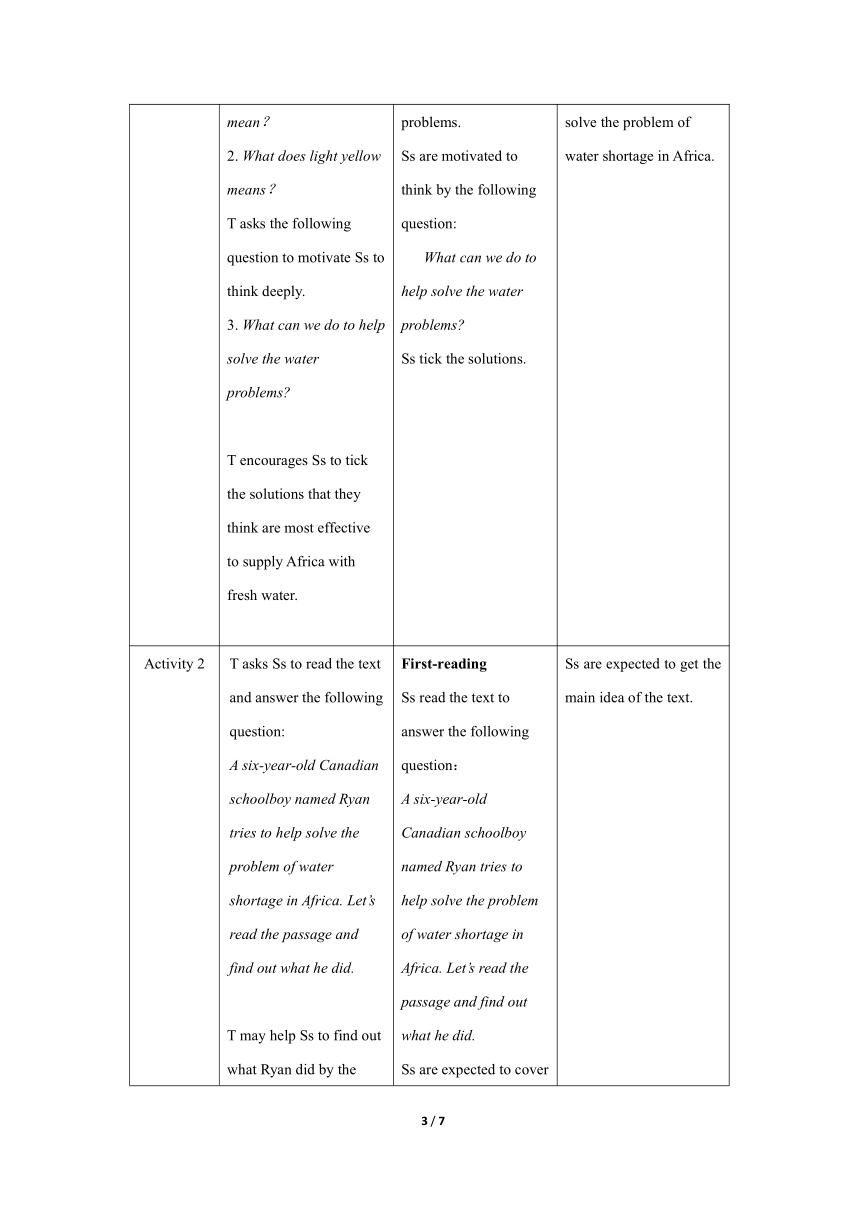外研版(2019)高中英语必修第三册 Unit2 Making a difference Understanding ideas 板块教学设计
文档属性
| 名称 | 外研版(2019)高中英语必修第三册 Unit2 Making a difference Understanding ideas 板块教学设计 |  | |
| 格式 | docx | ||
| 文件大小 | 28.2KB | ||
| 资源类型 | 教案 | ||
| 版本资源 | 外研版(2019) | ||
| 科目 | 英语 | ||
| 更新时间 | 2023-03-01 09:10:21 | ||
图片预览



文档简介
Unit2 Understanding ideas板块教学设计
Understanding ideas板块教学设计 (建议时长50分钟,教师可根据教学实际酌情调整。)
课型 Reading + Speaking
主题语境 人与自我——做人与做事
内容分析 Understanding idea部分共设计了5个学习活动,其中包括Think and share板块。 本板块呈现一篇描述普通人做公益事业的新闻特写,语篇类型为人物介绍,介绍介绍了一位名为Ryan的加拿大人从孩童时期起,坚持帮助非洲缺水地方的儿童解决饮水问题的事迹,有利于引导青少年学生勇于承担社会责任,从事公益事业和志愿服务积极帮助他人。 该语篇以时间线索展开,通过第一段“问题的提出”,第二段到第五段“问题的解决”和第六段“解决问题的意义”逐层推进。特别是第二段到第五段,一波三折,很好地体现了Ryan从事公益事业的三个阶段,即work hard alone to reach his first target of $70到ask for help from his classmates and neighbours to raise $2000 with the help of his mother’s friend到set up a foundation to encourage more people to help,体现了Ryan坚定地从事志愿活动,为实现自己的梦想持之以恒的努力。活动1是看图并谈论非洲国家淡水资源匮乏的问题,通过勾选为非洲提供淡水的举措,启动学生思考如何帮助非洲部分区域解决淡水问题,引导学生进入对于阅读语篇主题意义的探究。活动2是通过阅读理解课文的主要事实。活动3是通过阅读准确理解课文标题意义,要求学生对于自己的理解进行合理解释。活动4提供了四幅图片勾勒出Ryan从事公益事业的起因及经历,并通过补全句子帮助学生梳理记叙文的六要素,特别是事件的起因、经过和结果,有助于学生熟悉记叙文的语篇结构。 Think and Share部分共有两个问题,聚焦高阶思维,有利于学生进行评价,引导学生通过阐释原因,发展逻辑思维,并且通过引导学生思考自己如何帮助有需要的人,培养学生从事公益事业的意识。
教学目标 1. 通过完成教材14页到16页活动1、2和3,理解并能说出Ryan为解决非洲缺水问题所作的主要努力, 并能正确理解并说出标题的意义。 2. 通过完成教材16页活动4,能够复述课文的主要事实,并能结合记叙文六要素梳理Ryan参与公益事业的起因和过程;能够理解Ryan从最初的 “Why don’t I help”到 “How can I help today ”的变化;能够归纳出Ryan实现梦想的原因,并能够对于Ryan在参与公益事业和实现梦想过程中的不同阶段进行恰当评价。 3. 通过完成教材16页Think and Share,能够对Ryan进行整体评价,并能够深入思考自己如何帮助他人,初步形成积极参与公益事业的意识。
教学重点 通过阅读,获取Ryan从孩提时期到成年从事公益事业全过程的事实性信息,并能归纳概括Ryan从事公益事业的原因,理解Ryan从最初的“Why don’t I help”到“How can I help today ”的变化,归纳出Ryan实现梦想的原因,并能深入理解标题的意义,掌握记叙文六要素和语篇结构。
教学难点 理解Ryan从最初的“Why don’t I help”到“How can I help today ”的变化。
教学策略 PWP阅读教学模式
Teaching contents Procedures Purposes
Teacher’s activity Students’ activity
Activity 1 T asks the following question: 1. In the world, how much fresh water is there for each person to use every year on average T helps Ss to answer the question by guiding them to read the map. T asks more questions: 2. What does dark yellow mean? 2. What does light yellow means? T asks the following question to motivate Ss to think deeply. 3. What can we do to help solve the water problems T encourages Ss to tick the solutions that they think are most effective to supply Africa with fresh water. Viewing Ss answer T’s question: Ss can answer the question with the help of the map in A1. Ss look at the map again and answer T’s questions. Ss are guided to realize that some parts of Africa are facing water problems. Ss are motivated to think by the following question: What can we do to help solve the water problems Ss tick the solutions. Ss are motivated to think about the water problem. Ss are expected to enhance the ability to read paragraphs. Ss are expected to realize that some countries in Africa are badly in need of water. Ss are encouraged to think about how to help solve the problem of water shortage in Africa.
Activity 2 T asks Ss to read the text and answer the following question: A six-year-old Canadian schoolboy named Ryan tries to help solve the problem of water shortage in Africa. Let’s read the passage and find out what he did. T may help Ss to find out what Ryan did by the following structure: Ryan helps solve the problem by... At first… Later… While Ss are reading, T put down the title on the blackboard. T may guide Ss to understand what Ryan did quickly by reading the title. First-reading Ss read the text to answer the following question: A six-year-old Canadian schoolboy named Ryan tries to help solve the problem of water shortage in Africa. Let’s read the passage and find out what he did. Ss are expected to cover the following key points with the help of the structure given by T: Ryan help solve the problem by building wells. At first, he planned to earn money to build a well. Although building a well needed a lot of money, he raised enough money to build a well with determination. Later, he set up a foundation to encourage more people to help. Ss are expected to get the main idea of the text.
Activity 3 T asks Ss to read the title and asks them to answer the following questions: 1. Is it easy for a six-year-old boy to build a well 2. How did Ryan build the well and how did the well changed the world 3. Let’s read again and find them out. After reading, T encourages Ss to discuss their difficulties that arise in the process of reading each paragraph and helps them understand the meaning of the each paragraph. T asks more questions to help Ss to think deeply. Second-reading Ss read the title and think deeply by thinking about the following questions: 1. Is it easy for a six-year-old boy to build a well 2. How did Ryan build the well and how did the well changed the world Ss read the text again with T’s guidance “Let’s read again and find them out.” Ss discuss their difficulties. Ss answer the following questions in the process of reading each paragraph: What questions did Ryan ask when he knew people in Africa couldn’t get enough clean water Which adjective would you like to use to describe Ryan Why Why couldn’t $70 do much help Which adjective would you like to use to describe Ryan’s feeling when he learned that his seventy dollars was not enough How did Ryan raise enough money Which adjective does the writer use to describe Ryan Do you agree What did Ryan see in Uganda and how did he feel How did Ryan encourage more people to help And what is the result What question does Ryan ask today And what does it mean What quality helps Ryan realize his dream Ss are expected to fully understand the text. Ss are expected to realize that the key to realizing one’s dream is perseverance.
Activity 4 T asks Ss to complete the sentences and retell Ryan’s story with the help of the sentences in A4. T helps Ss summarize the six elements of a narrative and the structure of the text. Retell Ss retell Ryan’s story with the help of A4. Ss summarize the six elements of a narrative and the structure of the text with the help of T. Ss are expected to be clear about the structure of the text and be aware of the six elements and the structure of a narrative.
Think & Share T asks Ss to discuss the two questions. Discussion Ss discuss the two questions of this part. Ss are expected to develop their thinking capacity and realize that helping others is admired.
1 / 7
Understanding ideas板块教学设计 (建议时长50分钟,教师可根据教学实际酌情调整。)
课型 Reading + Speaking
主题语境 人与自我——做人与做事
内容分析 Understanding idea部分共设计了5个学习活动,其中包括Think and share板块。 本板块呈现一篇描述普通人做公益事业的新闻特写,语篇类型为人物介绍,介绍介绍了一位名为Ryan的加拿大人从孩童时期起,坚持帮助非洲缺水地方的儿童解决饮水问题的事迹,有利于引导青少年学生勇于承担社会责任,从事公益事业和志愿服务积极帮助他人。 该语篇以时间线索展开,通过第一段“问题的提出”,第二段到第五段“问题的解决”和第六段“解决问题的意义”逐层推进。特别是第二段到第五段,一波三折,很好地体现了Ryan从事公益事业的三个阶段,即work hard alone to reach his first target of $70到ask for help from his classmates and neighbours to raise $2000 with the help of his mother’s friend到set up a foundation to encourage more people to help,体现了Ryan坚定地从事志愿活动,为实现自己的梦想持之以恒的努力。活动1是看图并谈论非洲国家淡水资源匮乏的问题,通过勾选为非洲提供淡水的举措,启动学生思考如何帮助非洲部分区域解决淡水问题,引导学生进入对于阅读语篇主题意义的探究。活动2是通过阅读理解课文的主要事实。活动3是通过阅读准确理解课文标题意义,要求学生对于自己的理解进行合理解释。活动4提供了四幅图片勾勒出Ryan从事公益事业的起因及经历,并通过补全句子帮助学生梳理记叙文的六要素,特别是事件的起因、经过和结果,有助于学生熟悉记叙文的语篇结构。 Think and Share部分共有两个问题,聚焦高阶思维,有利于学生进行评价,引导学生通过阐释原因,发展逻辑思维,并且通过引导学生思考自己如何帮助有需要的人,培养学生从事公益事业的意识。
教学目标 1. 通过完成教材14页到16页活动1、2和3,理解并能说出Ryan为解决非洲缺水问题所作的主要努力, 并能正确理解并说出标题的意义。 2. 通过完成教材16页活动4,能够复述课文的主要事实,并能结合记叙文六要素梳理Ryan参与公益事业的起因和过程;能够理解Ryan从最初的 “Why don’t I help”到 “How can I help today ”的变化;能够归纳出Ryan实现梦想的原因,并能够对于Ryan在参与公益事业和实现梦想过程中的不同阶段进行恰当评价。 3. 通过完成教材16页Think and Share,能够对Ryan进行整体评价,并能够深入思考自己如何帮助他人,初步形成积极参与公益事业的意识。
教学重点 通过阅读,获取Ryan从孩提时期到成年从事公益事业全过程的事实性信息,并能归纳概括Ryan从事公益事业的原因,理解Ryan从最初的“Why don’t I help”到“How can I help today ”的变化,归纳出Ryan实现梦想的原因,并能深入理解标题的意义,掌握记叙文六要素和语篇结构。
教学难点 理解Ryan从最初的“Why don’t I help”到“How can I help today ”的变化。
教学策略 PWP阅读教学模式
Teaching contents Procedures Purposes
Teacher’s activity Students’ activity
Activity 1 T asks the following question: 1. In the world, how much fresh water is there for each person to use every year on average T helps Ss to answer the question by guiding them to read the map. T asks more questions: 2. What does dark yellow mean? 2. What does light yellow means? T asks the following question to motivate Ss to think deeply. 3. What can we do to help solve the water problems T encourages Ss to tick the solutions that they think are most effective to supply Africa with fresh water. Viewing Ss answer T’s question: Ss can answer the question with the help of the map in A1. Ss look at the map again and answer T’s questions. Ss are guided to realize that some parts of Africa are facing water problems. Ss are motivated to think by the following question: What can we do to help solve the water problems Ss tick the solutions. Ss are motivated to think about the water problem. Ss are expected to enhance the ability to read paragraphs. Ss are expected to realize that some countries in Africa are badly in need of water. Ss are encouraged to think about how to help solve the problem of water shortage in Africa.
Activity 2 T asks Ss to read the text and answer the following question: A six-year-old Canadian schoolboy named Ryan tries to help solve the problem of water shortage in Africa. Let’s read the passage and find out what he did. T may help Ss to find out what Ryan did by the following structure: Ryan helps solve the problem by... At first… Later… While Ss are reading, T put down the title on the blackboard. T may guide Ss to understand what Ryan did quickly by reading the title. First-reading Ss read the text to answer the following question: A six-year-old Canadian schoolboy named Ryan tries to help solve the problem of water shortage in Africa. Let’s read the passage and find out what he did. Ss are expected to cover the following key points with the help of the structure given by T: Ryan help solve the problem by building wells. At first, he planned to earn money to build a well. Although building a well needed a lot of money, he raised enough money to build a well with determination. Later, he set up a foundation to encourage more people to help. Ss are expected to get the main idea of the text.
Activity 3 T asks Ss to read the title and asks them to answer the following questions: 1. Is it easy for a six-year-old boy to build a well 2. How did Ryan build the well and how did the well changed the world 3. Let’s read again and find them out. After reading, T encourages Ss to discuss their difficulties that arise in the process of reading each paragraph and helps them understand the meaning of the each paragraph. T asks more questions to help Ss to think deeply. Second-reading Ss read the title and think deeply by thinking about the following questions: 1. Is it easy for a six-year-old boy to build a well 2. How did Ryan build the well and how did the well changed the world Ss read the text again with T’s guidance “Let’s read again and find them out.” Ss discuss their difficulties. Ss answer the following questions in the process of reading each paragraph: What questions did Ryan ask when he knew people in Africa couldn’t get enough clean water Which adjective would you like to use to describe Ryan Why Why couldn’t $70 do much help Which adjective would you like to use to describe Ryan’s feeling when he learned that his seventy dollars was not enough How did Ryan raise enough money Which adjective does the writer use to describe Ryan Do you agree What did Ryan see in Uganda and how did he feel How did Ryan encourage more people to help And what is the result What question does Ryan ask today And what does it mean What quality helps Ryan realize his dream Ss are expected to fully understand the text. Ss are expected to realize that the key to realizing one’s dream is perseverance.
Activity 4 T asks Ss to complete the sentences and retell Ryan’s story with the help of the sentences in A4. T helps Ss summarize the six elements of a narrative and the structure of the text. Retell Ss retell Ryan’s story with the help of A4. Ss summarize the six elements of a narrative and the structure of the text with the help of T. Ss are expected to be clear about the structure of the text and be aware of the six elements and the structure of a narrative.
Think & Share T asks Ss to discuss the two questions. Discussion Ss discuss the two questions of this part. Ss are expected to develop their thinking capacity and realize that helping others is admired.
1 / 7
